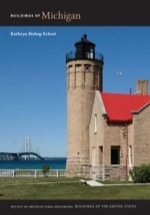
This rectangular, two-story, cross-gabled farmhouse, built by Adam Keebler and his son Will for their son and brother Charles and Adam's new wife, Zanah, embodies the persistence of the vernacular tradition of building with the materials most readily available and least expensive. In this case, ordinary conduit tiles were used for building material. The house is among the largest of several other utilitarian structures in the area—sheds, barns, and garages—built of local clay conduit tile. The nearby Grand Ledge Clay Products Company, which began operations in 1906, had available many “seconds” or rejects of the tile conduits. Glazed clay hollow conduit tiles were laid up in courses in much the same way as bricks. Here the walls are horizontal stretcher bond courses mortared, and the ends of the hollow tiles sealed with mortar. At the building's corners, the tile ends from each wall overlap in a manner reminiscent of the square notching technique used in log construction. When laid in double thickness as in the Keebler house, the tiles provided superb insulation against the severe cold Michigan winters and hot humid summers.

